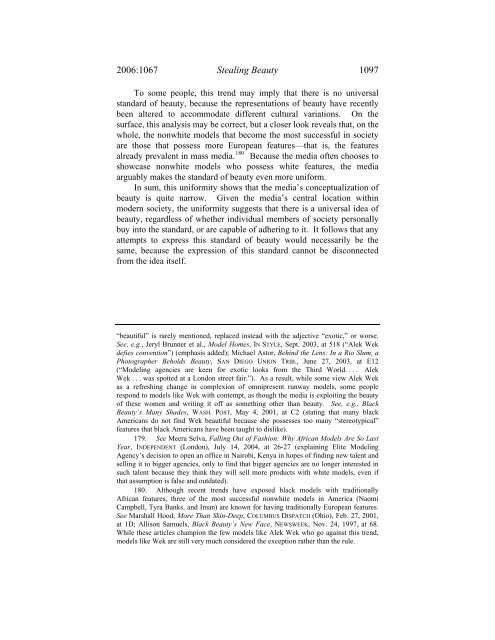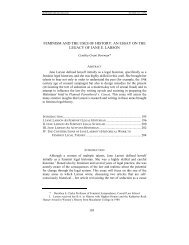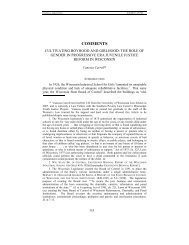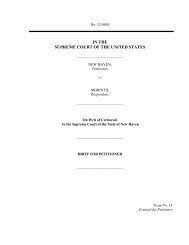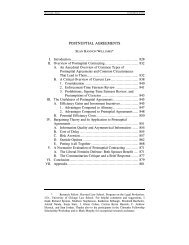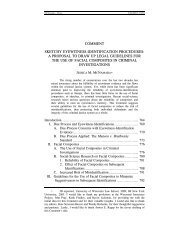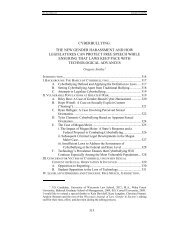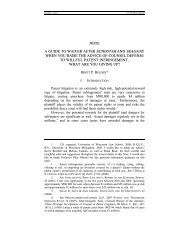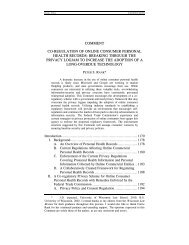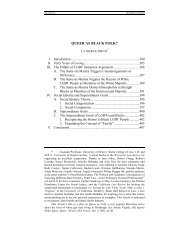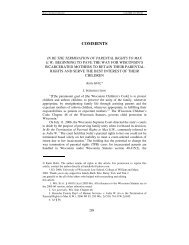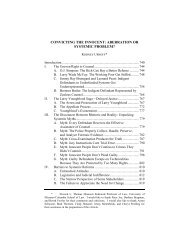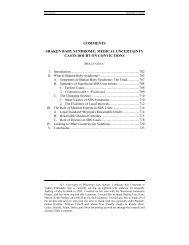Stealing Beauty: Pivot Point International v ... - UW Law School
Stealing Beauty: Pivot Point International v ... - UW Law School
Stealing Beauty: Pivot Point International v ... - UW Law School
You also want an ePaper? Increase the reach of your titles
YUMPU automatically turns print PDFs into web optimized ePapers that Google loves.
2006:1067 <strong>Stealing</strong> <strong>Beauty</strong> 1097<br />
To some people, this trend may imply that there is no universal<br />
standard of beauty, because the representations of beauty have recently<br />
been altered to accommodate different cultural variations. On the<br />
surface, this analysis may be correct, but a closer look reveals that, on the<br />
whole, the nonwhite models that become the most successful in society<br />
are those that possess more European features—that is, the features<br />
already prevalent in mass media. 180 Because the media often chooses to<br />
showcase nonwhite models who possess white features, the media<br />
arguably makes the standard of beauty even more uniform.<br />
In sum, this uniformity shows that the media’s conceptualization of<br />
beauty is quite narrow. Given the media’s central location within<br />
modern society, the uniformity suggests that there is a universal idea of<br />
beauty, regardless of whether individual members of society personally<br />
buy into the standard, or are capable of adhering to it. It follows that any<br />
attempts to express this standard of beauty would necessarily be the<br />
same, because the expression of this standard cannot be disconnected<br />
from the idea itself.<br />
“beautiful” is rarely mentioned, replaced instead with the adjective “exotic,” or worse.<br />
See, e.g., Jeryl Brunner et al., Model Homes, IN STYLE, Sept. 2003, at 518 (“Alek Wek<br />
defies convention”) (emphasis added); Michael Astor, Behind the Lens: In a Rio Slum, a<br />
Photographer Beholds <strong>Beauty</strong>, SAN DIEGO UNION TRIB., June 27, 2003, at E12<br />
(“Modeling agencies are keen for exotic looks from the Third World. . . . Alek<br />
Wek . . . was spotted at a London street fair.”). As a result, while some view Alek Wek<br />
as a refreshing change in complexion of omnipresent runway models, some people<br />
respond to models like Wek with contempt, as though the media is exploiting the beauty<br />
of these women and writing it off as something other than beauty. See, e.g., Black<br />
<strong>Beauty</strong>’s Many Shades, WASH. POST, May 4, 2001, at C2 (stating that many black<br />
Americans do not find Wek beautiful because she possesses too many “stereotypical”<br />
features that black Americans have been taught to dislike).<br />
179. See Meera Selva, Falling Out of Fashion: Why African Models Are So Last<br />
Year, INDEPENDENT (London), July 14, 2004, at 26-27 (explaining Elite Modeling<br />
Agency’s decision to open an office in Nairobi, Kenya in hopes of finding new talent and<br />
selling it to bigger agencies, only to find that bigger agencies are no longer interested in<br />
such talent because they think they will sell more products with white models, even if<br />
that assumption is false and outdated).<br />
180. Although recent trends have exposed black models with traditionally<br />
African features, three of the most successful nonwhite models in America (Naomi<br />
Campbell, Tyra Banks, and Iman) are known for having traditionally European features.<br />
See Marshall Hood, More Than Skin-Deep, COLUMBUS DISPATCH (Ohio), Feb. 27, 2001,<br />
at 1D; Allison Samuels, Black <strong>Beauty</strong>’s New Face, NEWSWEEK, Nov. 24, 1997, at 68.<br />
While these articles champion the few models like Alek Wek who go against this trend,<br />
models like Wek are still very much considered the exception rather than the rule.


